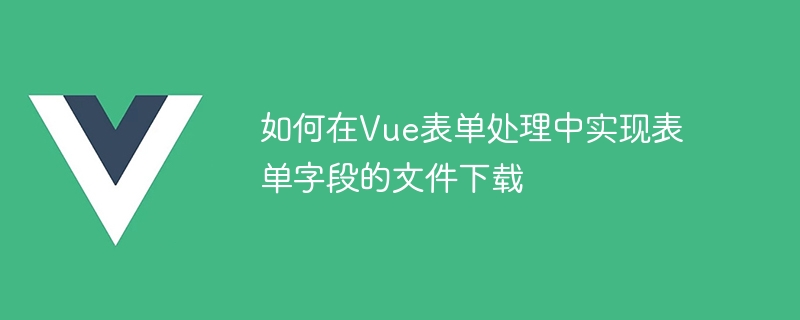

How to implement file download of form fields in Vue form processing
Introduction:
Vue.js is a popular JavaScript framework for building user interface. In Vue applications, we often need to handle form operations, and one of the common requirements is to implement file downloads. This article will introduce how to implement file download of form fields in Vue form processing and provide code examples.
1. Use the a tag of HTML to download files
The simplest way is to use the a tag of HTML. By setting its href attribute to the link address of the file, click the a tag to download the file.
HTML code:
<template>
<div>
<a :href="fileUrl" download>下载文件</a>
</div>
</template>Vue code:
<script>
export default {
data() {
return {
fileUrl: 'http://example.com/file.pdf' // 文件的链接地址
};
}
};
</script>Through the above code example, click the "Download File" link to download the file named file.pdf.
2. Use Fetch API to download files
If you need to obtain the download link of the file through the back-end interface, you can use the Fetch API to download the file.
Vue code:
<script>
export default {
methods: {
downloadFile() {
fetch('http://example.com/api/download', {
method: 'GET',
responseType: 'blob' // 声明返回数据类型为二进制数据
})
.then(response => response.blob())
.then(blob => {
const url = window.URL.createObjectURL(new Blob([blob]));
const link = document.createElement('a');
link.href = url;
link.setAttribute('download', 'file.pdf');
document.body.appendChild(link);
link.click();
document.body.removeChild(link);
});
}
}
};
</script>HTML code:
<template>
<div>
<button @click="downloadFile">下载文件</button>
</div>
</template>Through the above code example, after clicking the "Download File" button, the Vue component will request the file from the backend interface to obtain After obtaining the binary data, create a Blob object and dynamically create an a tag. Assign the URL of the Blob object to the href attribute of the a tag, set the download attribute to the name of the file to be downloaded, and then simulate clicking the a tag to download.
3. Use axios for file download
If axios has been used as the HTTP request library in the Vue application, file downloading can be achieved through the features of axios.
Vue code:
<script>
import axios from 'axios';
export default {
methods: {
downloadFile() {
axios({
url: 'http://example.com/api/download',
method: 'GET',
responseType: 'blob' // 声明返回数据类型为二进制数据
}).then(response => {
const url = window.URL.createObjectURL(new Blob([response.data]));
const link = document.createElement('a');
link.href = url;
link.setAttribute('download', 'file.pdf');
document.body.appendChild(link);
link.click();
document.body.removeChild(link);
});
}
}
};
</script>HTML code:
<template>
<div>
<button @click="downloadFile">下载文件</button>
</div>
</template>Through the above code example, call the axios method in the Vue component to send a GET request, and The returned data is set to binary data type. Then, the a tag is dynamically created, and the returned binary data is created as a Blob object and assigned to the href attribute of the a tag. Finally, simulate clicking on the a tag to download.
Summary:
This article introduces how to implement file downloading of form fields in Vue form processing, and provides three implementation methods: using the HTML a tag, using the Fetch API, and using axios. According to the specific request method and the data format returned by the back-end interface, select the most suitable method to implement file download. I hope this article is helpful to your needs of handling file downloads in Vue applications.
The above is the detailed content of How to implement file download of form fields in Vue form processing. For more information, please follow other related articles on the PHP Chinese website!




